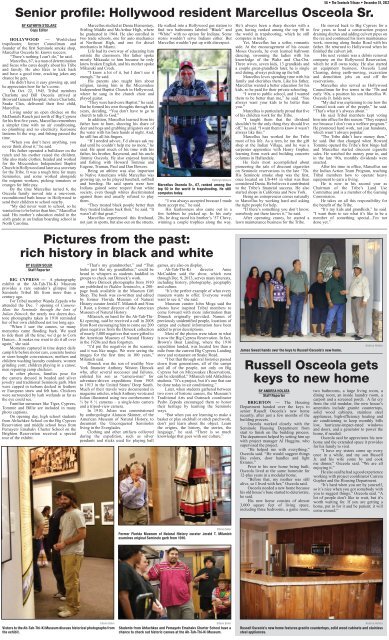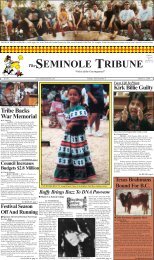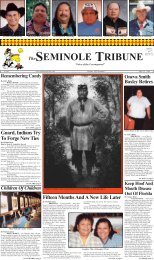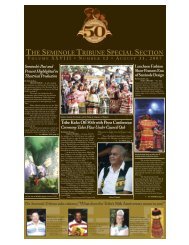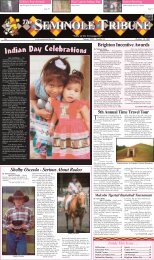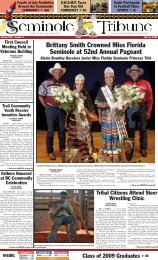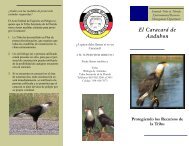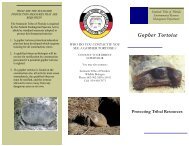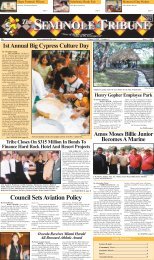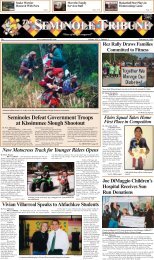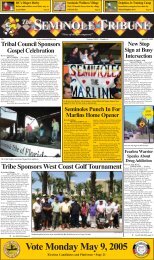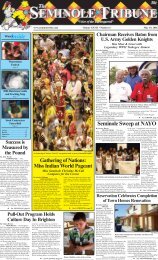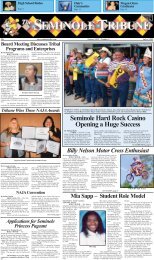You also want an ePaper? Increase the reach of your titles
YUMPU automatically turns print PDFs into web optimized ePapers that Google loves.
5A • The <strong>Seminole</strong> Tribune • <strong>December</strong> <strong>19</strong>, 2012Senior pr<strong>of</strong>ile: Hollywood resident Marcellus Osceola Sr.BY KATHRYN STOLARZCopy EditorHOLLYWOOD — World-classtrapshooter, former Councilman andfounder <strong>of</strong> the first <strong>Seminole</strong> smoke shop,Marcellus Osceola Sr. knows success.“There’s nothing I can’t do,” he said.Marcellus, 67, is a man <strong>of</strong> determinationand focus who cares deeply about his <strong>Tribe</strong>and family. He also likes to kick backand have a good time, cracking jokes anychance he gets.He didn’t have it easy growing up, andhe appreciates how far he’s come.On Oct. 22, <strong>19</strong>45, Tribal membersCharlotte and Bill Osceola arrived atBroward General Hospital, where Charlotte,Snake Clan, delivered their first child,Marcellus.Living under an open chickee on theMcDaniels Ranch just north <strong>of</strong> Big Cypressfor his first five years, Marcellus remembersa simpler time with no air conditioning,no plumbing and no electricity. Kerosenelanterns lit the way, and fishing passed thetime.“When you don’t have anything, younever think about it,” he said.His father operated a bulldozer on theranch and his mother raised the children.She also made clothes, beaded and workedfor the Miccosukee Independent BaptistChurch in Hollywood and later as a secretaryfor the <strong>Tribe</strong>. It was a tough time for many<strong>Seminole</strong>s, and some worked alongsidethe migrant workers, picking tomatoes ororanges for little pay.By the time Marcellus turned 6, theOsceola family moved into a one-room,reconditioned bath house in Hollywood tosend their children to school nearby.“My dad never went to school, so hewanted me to be better than him,” Marcellussaid. His mother’s education ended in thesixth grade at an Indian boarding school inNorth Carolina.Pictures from the past:rich history in black and whiteBY EILEEN SOLERStaff ReporterBIG CYPRESS — A photographyexhibit at the Ah-Tah-Thi-Ki Museumprovides a rare outsider’s glimpse into<strong>Seminole</strong> Tribal life from more than acentury ago.For Tribal member Wanda Zepeda whoattended the Dec. 7 opening <strong>of</strong> Camera-Man: the <strong>Seminole</strong> through the lens <strong>of</strong>Julian Dimock, the nearly two dozen duotonephotographs taken in <strong>19</strong>10 remindedher <strong>of</strong> her own childhood not too long ago.“When I saw the canoes, so manymemories came flooding back. We usedto ride them all the time; we’d go to CornDances…It makes me want to do it all overagain,” she said.Moments captured in time depict dailycamp life before motor cars, concrete homesor store-bought conveniences; mothers andchildren washing laundry outdoors; womengrinding corn; children playing in a canoe;men repairing camp chickees.In other photos, families pose forthe camera dressed in beaded and silverjewelry and traditional <strong>Seminole</strong> garb. Menwere capped in turbans decked in feathersor European straw and felt hats. Chickeeswere surrounded by lush wetlands as far asthe eye could see.Familiar surnames like Tiger, Cypress,Tommie and Billie are included in manyphoto captions.On opening day, high school studentsfrom Ahfachkee School on the Big CypressReservation and middle school boys fromPemayetv Emahakv Charter School on theBrighton Reservation received a specialtour <strong>of</strong> the exhibit.Marcellus studied at Dania Elementary,Stirling Middle and McArthur High, wherehe graduated in <strong>19</strong>64. He also enrolled intwo trade schools, one for auto mechanicsat Northeast High, and one for dieselmechanics in Miami.Life had its own way <strong>of</strong> educating himoutside the classroom. His father spokemostly Mikasuki to him because he onlyknew broken English, and his mother spokeMikasuki and Creek.“I know a lot <strong>of</strong> it, but I don’t use itenough,” he said.His parents also taught him aboutreligion, raising him in the MiccosukeeIndependent Baptist Church in Hollywood,where he sang in the church choir andplayed guitar.“They were hard-core Baptist,” he said.But he formed his own thoughts through theyears, deciding, “You don’t have to go tochurch to talk to God.”In addition, Marcellus learned from hisfather how to hunt, shooting his share <strong>of</strong>deer and hogs and grabbing alligators out <strong>of</strong>the water with his bare hands at night. And,he still has all his fingers.“If I needed advice, I’d always ask mydad until he couldn’t help me no more,” hesaid. He spent much <strong>of</strong> his time with hisfather, his brother, Raymond, and his uncleJimmie Osceola. He also enjoyed huntingand fishing with Howard Tommie andEugene, Truman, Paul and Dan Bowers.Being an athlete was also importantto Native Americans while Marcellus wasgrowing up, so he played baseball, s<strong>of</strong>tballand bowling. He said sports were howIndians gained some respect from whitesociety, even though whites discriminatedagainst them and usually refused to playthem.“They treated black people better thanthey treated Indians back then,” he said. “Itwasn’t all that great.”Marcellus experienced this firsthand,not just in sports, but also out on the streets.“That’s my grandmother,” and “Thatlooks just like my grandfather,” could beheard in whispers as students huddled ingroups to check out Dimock’s work.More Dimock photographs from <strong>19</strong>10are published in Hidden <strong>Seminole</strong>s, a 200-page book available in the Museum GiftShop. The book was co-written and editedby former <strong>Florida</strong> Museum <strong>of</strong> NaturalHistory curator Jerald T. Milanich and NinaJ. Root, a former director <strong>of</strong> the AmericanMuseum <strong>of</strong> Natural History.Milanich, on hand for the Ah-Tah-Thi-Ki opening, said he received a call in 2008from Root encouraging him to come see 200glass negatives from the Dimock collection<strong>of</strong> nearly 3,000 negatives that were gifted tothe American Museum <strong>of</strong> Natural Historyin the <strong>19</strong>20s and then forgotten.“I’d put the negatives in the scanner,and it was like magic. We were seeing theimages for the first time in 100 years,”Milanich said.Dimock was the son <strong>of</strong> wealthy NewYork financier Anthony Weston Dimockwho, after several successes and failures,enlisted his son as “camera-man” foradventure-driven expeditions from <strong>19</strong>03to <strong>19</strong>13 in the United States’ Deep South.Much <strong>of</strong> their travels were documented inmagazine articles, which Anthony wrote andJulian illustrated using two cumbersome 6½ by 8 ½ cameras – a single-lens cameraand a tripod-view camera.In <strong>19</strong>10, Julian was commissionedby anthropologist Alanson Skinner, <strong>of</strong> theAmerican Museum <strong>of</strong> Natural History, todocument the Unconquered <strong>Seminole</strong>sliving in the Everglades.Clothing and other artifacts collectedduring the expedition, such as silverpendants and sticks used for playing ballHe walked into a Hollywood gas station t<strong>of</strong>ind two bathrooms labeled “Black” and“White” with no option for Indians. Somestores wouldn’t serve Indians either. ButMarcellus wouldn’t put up with disrespect.Kathryn StolarzMarcellus Osceola Sr., 67, ranked among thetop 50 in the world in trapshooting. He stillcompetes today.“I was always accepted because I madethem accept me,” he said.His fearlessness also came out in afew hobbies he picked up. In his early20s, he drag raced his brother’s ’57 Chevy,winning a couple trophies along the way.games, are also on display.Ah-Tah-Thi-Ki director AnneMcCudden said the show, which runsthrough Dec. 9, 2013, serves many interests,including history, photography, geographyand culture.“It’s the perfect example <strong>of</strong> what everymuseum wants to <strong>of</strong>fer. Everyone wouldwant to see it,” she said.Museum curator John Moga said thephotos have inspired Tribal members tocome forward with more information thanDimock originally provided. Names <strong>of</strong>previously unidentified people, locations <strong>of</strong>camps and cultural information have beenadded to prior descriptions.Most <strong>of</strong> the photos were taken in whatis now the Big Cypress Reservation. In fact,Brown’s Boat Landing, where the <strong>19</strong>10expedition landed, was located less than amile from the current Big Cypress Landingstore and restaurant on Snake Road.“I bet that through oral histories passeddown from generations, all <strong>of</strong> the campsand all <strong>of</strong> the people, not only on BigCypress but on Miccosukee (Reservation),can be identified,” Milanich told Ahfachkeestudents. “It’s a project, but it’s one that canbe done today in air conditioning.”Later, when students gathered betweentwo rows <strong>of</strong> historic canoes, the Museum’sTraditional Arts and Outreach coordinatorPedro Zepeda encouraged them to honortheir heritage by learning the <strong>Seminole</strong>ways.“But when you are learning to make abasket or play stickball or stitch patchwork,don’t just learn about the object. Learnthe origins, the history, the stories, thelanguage,” he said. “There is so muchknowledge that goes with our culture.”He’s always been a sharp shooter with agun, having ranked among the top 50 inthe world in trapshooting, which he stillcompetes in today.Yet, Marcellus has a s<strong>of</strong>ter, romanticside. At the encouragement <strong>of</strong> his cousinMoses Osceola, he even learned ballroomdancing, swooning the ladies with hisknowledge <strong>of</strong> the Waltz and Cha-Cha.Three wives, seven kids, 13 grandkids anda couple great-grandkids later, he is singleand dating, always picking up the bill.Marcellus loves spending time with hisfamily and cherishes them. Like his father,Marcellus wanted a better education for hiskids, so he paid for their private schooling.“I went to public school, and I wantedthem to be better than me,” he said. “Youalways want your kids to be better thanyou.”Marcellus is particularly proud that five<strong>of</strong> his children work for the <strong>Tribe</strong>.“I taught them that the dividendshouldn’t be the only thing they should live<strong>of</strong>f,” he said. “I want them to know it wasn’talways like this.”Marcellus has worked for the <strong>Tribe</strong>most <strong>of</strong> his life. As a teen, he ran the giftshop at the Indian Village, and he was acarpenter apprentice with Henry Gopher,learning form work and building concretecolumns in Hallandale.He feels most accomplished aboutpioneering the sale <strong>of</strong> discount cigaretteson <strong>Seminole</strong> reservations in the late ‘70s.His <strong>Seminole</strong> smoke shop was the first,once located on US-441 in what was thenconsidered Dania. He believes it contributedto the <strong>Tribe</strong>’s financial success. He alsostarted shops in California and New York.Being an entrepreneur comes naturallyto Marcellus by working hard and askingthe right people for help.“If there’s something you don’t know,somebody out there knows it,” he said.After operating cranes, he started alawn maintenance business for the <strong>Tribe</strong>.James Sweat hands over the keys to Russell Osceola’s new home.BRIGHTON — The HousingDepartment handed over the keys tosenior Russell Osceola’s new homerecently, after just a few months <strong>of</strong> thebuilding process.Osceola worked closely with the<strong>Seminole</strong> Housing Department fromstart to finish on the building process.The department helped by setting him upwith project manager Al Huggins, whosupervised the project.“He helped me with everything,”Osceola said. “He would suggest thingslike colors, door handles and lightfixtures.”Prior to his new home being built,Osceola lived at the same homesite for12-plus years in a modular home.“Before that, my mother was stillalive, so I lived with her,” Osceola said.Osceola needed a new home becausehis old house’s base started to deteriorate,he said.His new home consists <strong>of</strong> almost3,000 square feet <strong>of</strong> living space,including three bedrooms, a game room,Andrea HolataRussell Osceola getskeys to new homeBY ANDREA HOLATAStaff ReporterHe moved back to Big Cypress for afew years to head a construction projectdraining ditches and adding culvert pipes onthe rez and continued his lawn maintenancework, mowing along Snake Road with hisfather. He returned to Hollywood when hefinished the culvert job.His next venture was a debris removalcompany on the Hollywood Reservation,which he still owns today. He also startedan equipment business, Osceola LandClearing, doing earth-moving, excavationand demolition jobs on and <strong>of</strong>f thereservations.Marcellus also served as HollywoodCouncilman for five terms in the ‘70s andearly ‘80s, a position his son Marcellus W.Osceola Jr. holds now.“My dad was explaining to me how theCouncil took care <strong>of</strong> the people,” he said.“That’s what it’s always about.”He said Tribal members kept votinghim into <strong>of</strong>fice for this reason: “They respectme because I don’t run a welfare program.”He promoted hard work, not just handouts,which wasn’t always popular.“The <strong>Tribe</strong> didn’t have money then,”he said. But that changed when HowardTommie opened the <strong>Tribe</strong>’s first bingo halland Marcellus started discount cigarettesales. He watched the money pour in, andin the late ‘80s, monthly dividends wereenacted.After his time in <strong>of</strong>fice, Marcellus ranthe Indian Action Team Program, teachingTribal members how to operate heavyequipment to earn a living.He is now in his second year asChairman <strong>of</strong> the <strong>Tribe</strong>’s Land UseCommittee and is a member <strong>of</strong> the GamingCommission.He takes on all this responsibility forthe benefit <strong>of</strong> the <strong>Tribe</strong>.“It’s my kids and grandkids,” he said.“I want them to see what it’s like to be amember <strong>of</strong> something special...I’m notdone yet.”two bathrooms, a large living room, adining room, an inside laundry room, acarport and a screened porch. A far cryfrom the old modular, the new house’samenities include granite countertops,solid wood cabinets, stainless steelappliances, high-efficiency heating andair conditioning to keep monthly billslow, hurricane-impact-rated windowsand doors, and a generator to power thehome, if needed.Osceola said he appreciates his newhome and the extended space it providesfor his family to visit.“I have my sisters come up everyonce in a while, and my son RussellJr. and his wife come by and cookme dinner,” Osceola said. “We are allenjoying it.”He also said he had a good experienceworking with project coordinator CarreraGopher and the Housing Department.“It’s hard when you are by yourself,so it’s nice when you got somebody withyou to suggest things,” Osceola said. “Alot <strong>of</strong> people don’t like to wait, but it’sworth waiting for. If you are getting ahome, put in for it and be patient; it willcome around.”Eileen SolerFormer <strong>Florida</strong> Museum <strong>of</strong> Natural History curator Jerald T. Milanichexamines original <strong>Seminole</strong> garb from <strong>19</strong>10.Eileen SolerVistors to the Ah-Tah-Thi-Ki Museum discuss historical photographs fromthe exhibit.Eileen SolerStudents from Ahfachkee and Pemayetv Emahakv Charter School have achance to check out historic canoes at the Ah-Tah-Thi-Ki Museum.Andrea HolataRussell Osceola’s new home features granite countertops, solid wood cabinets and stainlesssteel appliances.


